Eurovision 2009
This is just a quick update (sorry, but it’s pretty late, and there’s a lot going on tomorrow). Some of the parties tonight have just gotten a bit wilder, as Norway just won the Eurovision contest.
Here is the winning song:
An Expat's Experiences Abroad

This is just a quick update (sorry, but it’s pretty late, and there’s a lot going on tomorrow). Some of the parties tonight have just gotten a bit wilder, as Norway just won the Eurovision contest.
Here is the winning song:
I finally get to talk about the Russ tradition! I’ve been looking forward to this for a while, but now that I finally have some pictures, and have been able to talk to people about this, I feel that I still don’t really know enough to provide an adequate description of this tradition. I do, however, find this tradition amazingly fascinating. –From what I can tell, no other country has anything quite like this. Even Sweden and Denmark don’t have anything like this from what I’ve been told. But enough talk, I’ve hyped this up so much that the rest of this post probably won’t be able to match it.
It is easiest to equate a Russ to a high school senior, although that’s not quite right. There are three categories of students at this level. First, there are those students in some sort of trade school who might become a mechanic, an electrician, or other blue collar jobs. Second, you have students who will become something the equivalent of white collar workers, but without going to college. –Some of these students might actually stick around for another year if they decide they do want to go to a university. Finally, you have the students who are preparing to go to college, and these are the students who will stick out the most during early May.
In Norway, classes for seniors end around the end of April. May 1 is traditionally considered the start of the Russ season. Now, don’t get me wrong, there will be different events these students hold all during their final year, but it’s the end of classes when things really kick off. As I said, classes finish up around the end of A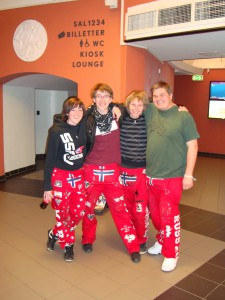 pril, but students still have to take exams, which start after Norway’s Constitution day (May 17). This means students have close to three weeks to study. Can you guess how much studying they seem to actually get done? Yeah, definitely not three weeks’ worth.
pril, but students still have to take exams, which start after Norway’s Constitution day (May 17). This means students have close to three weeks to study. Can you guess how much studying they seem to actually get done? Yeah, definitely not three weeks’ worth.
Meet Mari, Hans Marius, Marius, and Kenneth. I met them while waiting to see the Star Trek movie (it started at 12:01 on Friday morning, making for a tough day at work later, I probably don’t need to tell you). Unfortunately I can’t tell you too much about these students individually, since we spent the time we had speaking about the traditions of this time of year. From the little time we had to speak, they seem like good people, and they were quite happy to tell me what it is to be Russ.
You will notice that they are all wearing similar pants, which is part of the tradition. Red pants mean that they are in the third academic track I mentioned above, and they plan to attend a university. Students wear blue pants if they’re in the second group, and the students going to a trade school will wear black pants, if they participate at all. The students decorate their pants with iron on patches, writing, and many have their names on one of the legs, such as you can sort of see with Mari. Friends will often sign the pants as well. They will wear these pants from around May 1 (sometimes earlier) through the 17th. Every day. All day. And part of the tradition is that they don’t get washed.
Another piece of the tradition are russekorter. The size of a business card, russekorter usually have a picture of the student, possibly some contact information, and a joke of some sort. The picture generally isn’t serious. It might be a baby picture or something that was taken at a party. The joke? From what I’ve seen, they’re usually pretty bad. If you’d like to see an example, take a look at this post, presumably by Ronja Røverdatter. Children often go around collecting these cards.
Finally – well, in regards to what I’m going to write about tonight – are the russebuser, the Russ buses. Traditionally students might drive around in a van with as large of a sound system they can afford and drive around drinking (not the driver, of course) all through the night. In the larger cities, especially in Oslo, they’ve taken this a step further. Some students will band together to buy a bus and outfit it with a sound system. Just in case you think I mistyped, I didn’t – they will actually buy a bus. Apparently this can cost in the range of a million kroner, or somewhere in the $200,000 range. You can see below a couple of pictures of one of the buses. If I get a chance to see the insides of any others, I’ll post more pictures later.
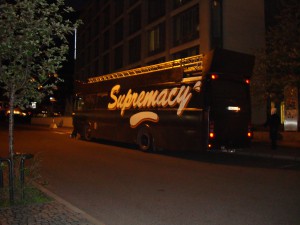
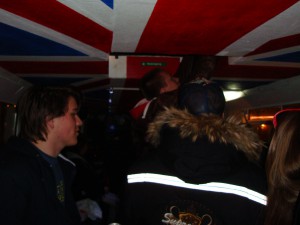
There are more traditions associated with this time of year, but I haven’t really heard enough to write about them. Hopefully I will be able to do so sometime next week. I also hope others find this as interesting as I do. As strange as some of this may seem, it’s important to remember that there are traditions that we have in America that are also rather unique. Prom, yearbooks (for the most part), and the walk across a stage to receive their diploma are not something that graduating students usually experience in Norway, so it’s really not surprising that they have developed their own traditions.
May 1st is Norway’s labor day. Of course, the day means different things to different people. To some, it’s a day to celebrate workers. To others, it’s the day you start planting your garden, and to others, it’s simply a day to relax. It also represents the start of something else, but that will wait until I have the best picture and story to explain it.
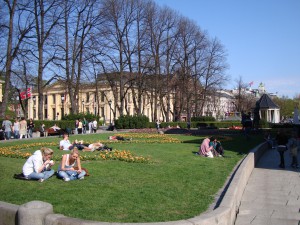 Sunbathers Friday was an amazingly warm day – not hot, but warm enough to go out in shorts and a T-shirt. I spent a few hours just walking around – it may not have been as much of a workout as going to the gym, but it was nice just the same. As you can see, I wasn’t the only one who thought it was a nice day. This picture was taken by the theater, but other parks, Frognerparken especially, were quite crowded.
Sunbathers Friday was an amazingly warm day – not hot, but warm enough to go out in shorts and a T-shirt. I spent a few hours just walking around – it may not have been as much of a workout as going to the gym, but it was nice just the same. As you can see, I wasn’t the only one who thought it was a nice day. This picture was taken by the theater, but other parks, Frognerparken especially, were quite crowded.
With the holiday halfway over, I’ve been feeling more rested, and was interested in doing something a little different today. The weather was really nice, and a coworker had previously suggested that I come with her to an animal shelter, and today we made it up there.
The shelter is called FOD, and it’s sort of on the southern edge of the city, about a 20 minute bus ride from the main bus terminal followed by a 15 minute walk more or less into the woods.
 Once there, we got to take a couple of dogs out for a walk. They were very well behaved and were pros at begging for treats. After taking the dogs for a walk, we were introduced into some very cute puppies. All in all, it was a nice and relaxing afternoon, and walking the dogs was a nice change from going to the gym.
Once there, we got to take a couple of dogs out for a walk. They were very well behaved and were pros at begging for treats. After taking the dogs for a walk, we were introduced into some very cute puppies. All in all, it was a nice and relaxing afternoon, and walking the dogs was a nice change from going to the gym.
The Easter holidays start on Thursday. Actually, for many Norwegians, the holiday started last Friday. While around 90% of Norwegians technically belong to the Evangelical-Lutheran Church of Norway, this is not an overly religious country. For many Norwegians in Oslo, this long weekend is a chance for them to go skiing one last time before spring really arrives. Plus, the holidays related to Easter guarantee a minimum number of days off.
In Norway, you only get a day off for a public holiday if you are normally scheduled to work on the day it falls. This means that since Norway’s Constitution Day (May 17) falls on a Sunday this year, it’s not a real holiday to me – I have to be at work the Friday before and the Monday after. It seems strange to me. So this year, even though there are 10 public holidays, only 8 of them are actually days off for me, and it looks like next year will be even worse – 3 of the days fall on the weekend, as does January 1, 2011. Darn.
For those of you who are curious, here are the public holidays for 2009:
1 Jan New Year’s Day.
9 Apr Holy Thursday.
10 Apr Good Friday.
13 Apr Easter Monday.
1 May May Day.
17 May Constitution Day.
21 May Ascension.
1 Jun Whit Monday.
25-26 Dec Christmas.
There is something of a tradition in the eastern part of Norway to travel to Sweden on occasion to buy stuff, especially alcohol and tobacco, where it is generally much cheaper. From Oslo, it takes around 1 1/2 to 2 hours each way to get to a town in Sweden where you can get your shopping done. I was invited to go with some people on Saturday, and it was amazing just how many people were out there getting their shopping done. Obviously there are some limitations – on alcohol and tobacco at least, there are limits on how much you can bring back into Norway without having to pay customs – it’s around 2 liters of wine, 1 liter of spirits, and some amount of beer – I think 2 liters, but I’m not sure.
This trip is called a “Harrytur”, or at least it has been for the past few years – since around 2002 when a politician named Lars Sponheim said the practice was “Harry”. “Harry” is a derogatory term that has been around since the beginning of the 20th century and suggests that something is low-class or in bad taste. Still, the Harrytur is popular, especially when 100 Swedish Kroners are only worth around 80 Norwegian Kroners.
Of course, as an American, I looked at this as a road trip, another great tradition!
So, one of the many reasons I don’t post as much as I’d like to is I’m still taking Norwegian classes. Level 2 has started, and I am learning quite a bit. I think I will try to take level 3 before taking a break (3 hours of classes twice a week really does take it’s toll).
The hardest part of learning Norwegian is understand what people say. I’m getting closer, though. When listening to the radio or watching TV, I can make out many more words, although I often don’t have time to translate what is being said, even if I should know it. Much of this now is getting to the point where I really know the words, to the point where I don’t have to translate everything that is being said.
At one po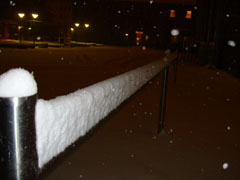 int I was wondering if winter would ever arrive in Oslo. Well, it did! The picture on the right was taken in January, and illustrates just how much snow was falling at times! There were a couple of weekends that were more or less nonstop snow!
int I was wondering if winter would ever arrive in Oslo. Well, it did! The picture on the right was taken in January, and illustrates just how much snow was falling at times! There were a couple of weekends that were more or less nonstop snow!
Much of the snow has melted, but there are still piles along many roads, and in some parts of town, the sidewalks aren’t completely clear yet. In fact, there was more snow this weekend, but it did not really stick. –I’m talking about in Oslo, near the center of the city. The further out you get, the more snow there is. It’s important to remember that the city is situated more or less in a bowl. The center of the city is located on the Oslofjorden, and the rest of the city rises up around it. This is also why you can reach ski locations in less than an hour on the trams.
I am more or less ready for spring to arrive, however. Don’t get me wrong, I love snow, but after a while you get tired of the ice and puddles of water. From what I hear, though, our current weather may continue for a while – maybe into April. Whatever comes, I’m sure I’ll manage.
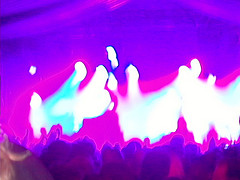 As an American, the way Norwegians party is somewhat different than what we’re used to. While in America, you might just go to a club (or two or three) for the whole night, it’s quite a bit different over here.
As an American, the way Norwegians party is somewhat different than what we’re used to. While in America, you might just go to a club (or two or three) for the whole night, it’s quite a bit different over here.
Remember that alcohol is much more expensive in Norway. This means that while Oslo isn’t a huge city, the prices of alcohol at bars and clubs are on the high side. –You can easily pay between $7-$10 for a beer, and $13 or more for a mixed drink. Partying in Oslo is a bit different because of this. Typically you start your drinking at someone’s house or apartment, and you’ll probably be buzzed or more by the time you leave – often around midnight – to go to a club. The clubs are open until 3am (that’s when they’re required to stop serving alcohol, and although I don’t think they have to close then, they probably figure there’s no point to stay open if they’re not making money). After that, you may go to an after-party (I’ll have to get the spelling for the Norwegian terms). The after party is much more subdued since people try to be polite to those living around them who may not be up as late, but can last until it’s daylight.
When you get invited to a party, there are a couple of main things to remember. First, bring alcohol – whether you prefer beer, wine, or something else, bring your own drinks. Even though it’s cheaper to buy beer in the grocery stores or wine & sprirts at the Vinmonopolet, it’s still not cheap. –A six pack of beer (3 liters) such as Tuborg, Hansa, or the other brands will still cost you between 100 and 200 Kroners (approximatly $15-$30), so you can imagine how much the booze for 15 people would end up costing if one person had to buy it. If you do forget the first time, you’ll probably be ok since you’ll have the foreigner thing going for you, and nobody will say anything, but I doubt you want to make the same mistake twice. The second thing to remember is that everyone takes off their shoes at the door. Especially in the winter when it can be rather messy out, you don’t want to be tracking mud all over the floor.
I doubt you’ll have much trouble finding people to talk to at a party – people are all very polite, although occasionally you’ll find people who are embarassed to speak much English (unlike the typical Norwegian who loves to practice), but overall people love to find out more about you. Also, score bonus points by asking them to help you with pronunciation or to teach you a new word or phrase. 🙂
I’ve mentioned it before, but it can be rather difficult to meet people in Norway. While people at work are friendly, work and after work are very different, and coworkers rarely seem to go out together for drinks or anything else. In America especially, but also in many other places, if you go to a bar by yourself, you can probably still find people to talk to. In Norway? Not so much.
So how do you meet people? I’m still trying to find out, but I do have some advice that I have come up with or received from others:
If all else fails, you can still try and talk to random people, just don’t be surprised if they look at you like you’re crazy.